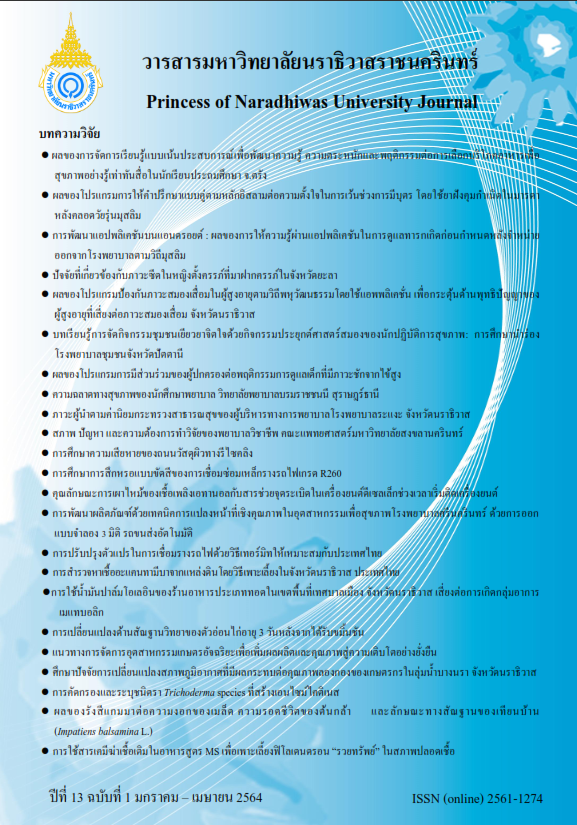Survey of Free-living Amoeba from Soil Sources using Culture Method in Narathiwat Province, Thailand
Keywords:
Free-living amoeba, Acanthamoeba spp., soil, NarathiwatAbstract
Acanthamoeba spp. are free-living amoeba found in the natural environment Acanthamoeba spp. can cause Acanthamoeba keratitis (AK) and Granulomatous Amoebic Encephalitis (GAE) in human. The aim of this study was to survey the prevalence of Acanthmoeba spp. from soil samples including Bacho, Yi-ngo and Ra-ngae district in Narathiwat province, Thailand by culture method. Identification of Acanthamoeba strains was based on the morphology of the cyst forms according to the criteria given by Pussard and Pons. Of the 60 soil samples, the result showed that the overall prevalence of Acanthamoeba spp. was 73.3%. No significant difference in prevalence was found on sampling areas in each district (p>0.05). Based on Pussard and Pons classification, the most Acanthamoeba cysts were classified as group III in all of the 3 districts. The highest cyst number was found in Yi-ngo district at 45 percent while Ra-ngae and Bacho district were 35 and 30 percent, respectively, followed by group II that was found in Ra-ngae district at 25 percent. In addition, group I was found in Bacho district at 15 percent. This is the first report of Acanthamoeba spp. from soil sources in Narathiwat province of Thailand, and the results suggest that more attention is needed to protect, which might be the population in the areas can infect Acanthamoeba spp.
References
Bunsuwansakul, C., Mahboob, T., Hounkong, K., Laohaprapanon, S., Chitapornpan, S., Jawjit, S., Yasiri, A., et al. (2019). Acanthamoeba in Southeast Asia – Overview and Challenges. The Korean Journal of Parasitology, 57 (4), 341-357.
Buppan, P., Meeboon, C., Klamsiri, T., Ko- amornsup, W., Promyuttana, W., Kosuwin, R., et al., (2018). Survey of Acanthamoeba spp. in Water Samples from the Public Park of Thailand. Journal of Research Unit on Science, Technology and Environment for Learning, 9(1), 36-45.
Chan, L.L., Mak, J.W., Low, Y.T., Koh, T.T., Ithoi, I., & Mohamed, S.M. (2011). Isolation and characterization of Acanthamoeba spp. from air-conditioners in Kuala Lumpur, Malaysia. Acta Tropica, 117(1), 23-30.
Denet, E., Coupat-Goutaland, B., Nazaret, S., Plandakis, M., & Favre-Bont, S. (2017). Diversity of free-living amoebae in soils and their associated human opportunistic bacteria. Parasitology Research, 116, 3151-3162.
Diaz, J. H. (2010). Incresing intracerebral infections caused by free-living amebae in the United States and worldwide. Journal of Neuroparasitology, 1, 1-10.
Jariya, P., Lerlaituan, P., & Warachoon, K. (1922). Acanthamoeba spp.: a cause of chronic granulomatous amoebic meningoencephalitis. Siriraj Hospital Gazette, 44, 148-153.
Jongwutiwes, S., Pariyakanok, L., Charoenkorn, M., Yagita, K., & Endo, T. (2000) Heterogeneity in cyst morphology within isolates of Acanthamoeba from keratitis patients in Thailand. Tropical Medicine and International Health, 5, 335-340.
Lekkla, A., Suttikornchai, C., Bovornkitti, S., & Sukthana, Y. (2005). Free-living ameba contamination in natural hot springs in Thailand. The Southeast Asian Journal of Tropical Medicine and Public Health, 36(4), 5-9.
Lorenzo-Morales, J., Khan, N. A., & Walochnik, J. (2015). An update on Acanthamoeba keratitis: diagnosis, pathogenesis and treatment. Parasite, 22, 1-20.
Meighani, M., Eslamirad, Z., Hajihossein, R., Ahmadi, A., & Saki, S. (2018). Isolation and Genotyping of Acanthamoeba from Soil Samples in Markazi Province, Iran. Open Access Macedonian Journal of Medical Sciences, 6(12), 2290 – 2294.
Mohaghegh, M. A., Azimi Resketi, M., Mohammadimanesh, R. Mehdi, A., Farzaneh, M., Mohammad, F., et al. (2016). Soil contamination with free-living amoeba in north of Iran. International Journal of Infection, 3(4), e37923. doi: 10.17795/iji-37923.
Nacapunchai, D., Kino, H., Ruangsitticha, C., Sriwichai, P., & Ishih, A. (2001). Terada M. A brief survey of free-living amebae in Thailand and Hamamatsu District, Japan. The Southeast Asian Journal of Tropical Medicine and Public Health, 32, 179-182.
Pussard, M., & Pons, R. (1977). Morphologie de la paroi kystique et taxonomie du genre Acanthamoeba (Protozoa, Amoebida). Protistologica, 13(4), 557-598.
Reyes-Batlle, M., Todd, C.D., Martin-Navarro, C.M., Lopez-Arencibia, A., Cabello-Vilchez, A.M., Gonzalez, A.C., Cordoba-Lanus, E., Lindo, J.F., Valladares, B., Pinero, J.E., & Lorenzo-Morales, J. (2014). Isolation and characterization of Acanthamoeba strains from soil samples in Gran Canaria, Canary Islands, Spain. Parasitology Research, 113(4), 1383-1388.
Scheikl. U., Sommer, R., Kirschner, A., Rameder, A., Schrammel, B., Zweimuller, I., et al. (2014). Free-living amoebae (FLA) co-occurring with legionellae in industrial waters. European Journal of Parasitology, 50(4), 422-429.
Siddiqui, R., & Khan, N. A. (2012). Biology and pathogenesis of Acanthamoeba. Parasite and Vectors, 5, 1-13.
Suwancharoen, C., & Srichoom, W. (2017). Survey of Acanthamoeba in natural water sources in communities around the University of Phayao, Phayao province, Thailand. Journal of Public Health, 47(3), 255-263.
Tanveer, T., Hameed, A., Muazzam, A.G., Jung, S.Y., Gul, A., & Matin, A. (2013). Isolation and molecular characterization of potentially pathogenic Acanthamoeba genotypes from diverse water resources including household drinking water from Khyber Pakhtunkhwa, Pakistan. Parasitology Research, 112(8), 2925-2932.
Thammaratana, T., Laummaunwai, P. & Boonmars, T. (2016). Isolation and identification of Acanthamoeba species from natural water sources in the northeastern part of Thailand. Parasitology Research, 115(4), 1705-1709.
Trabelsi, H., Dendana, F., Sellami, A., Sellami, H., Cheikhrouhou, F., Neji, S., et al., (2012) Pathogenic freeliving amoebae: epidemiology and clinical review. Pathologie Biologie, 60(6), 399–405.
Wannasan, A., Chaiwong, P., Bunchoo, M., Morakote, N. (2009). Occurrence of thermotolerant Naegleria and Acanthamoeba in some natural water sources in Chiang Mai. Chiang Mai Medical Journal, 48, 117-124.
Yaicharoen, R., Ngrenngarmlert, W., Thongmee, P. & Damsaman, W. (2007). Survey of Acanthamoeba spp. in dust from Bangkok and suburban areas. Journal of Associated Medical Sciences, 40(1), 46-53.




